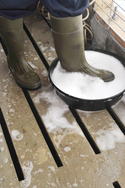Greasy Pig Disease

Greasy pig disease, also known as exudative epidermitis, it is caused by various strains of the Staph Hyicus bacteria. According to an article by the the National Animal Disease Information Service, Pig Health – Greasy Pig Disease, the bacteria live on the skin surface of pigs, but will require a trigger to produce the disease.
These triggers may be anything from damage to the skin, other diseases, faeces over the skin or high humidity levels that produce a moisture layer on the skin of the pigs, in which the bacteria can multiply. The disease causes the appearance of thick orange, brown to black greasy matter on the head and body of pigs and usually affect younger pigs, such as sucklers and weaners.
It is especially lethal in younger piglets, as it leads to dehydration. In older pigs it may cause wounds to heal slowly, resulting in the condemnation of the skins at the abattoir.
Treatment
The use of shampoo or soap can help to remove and kill some of the bacteria, but pigs usually require the use of antibiotics. Ask a veterinarian for advice on which antibiotic to use, to target the specific strain of bacteria responsible for the disease.
Care should be taken to supply young affected piglets with enough water as well as electrolytes to prevent dehydration. Pigs with greasy skin disease should be separated from healthy pigs to prevent the bacteria from spreading to other pigs. Good hygiene should be practised to keep the number of greasy disease-causing bacteria low.
The cause of infection should also be addressed to prevent future outbreaks, be it injuries to the skin, other diseases, unhygienic conditions or climatic conditions that cause excess moisture on the skin layer.
Diamond Skin Disease
Diamond skin disease, also known as Erysipelas, is caused by the (Erysipelothrix rhusiophathiae) bacterium, found on most pig farms. According to the Pig Site’s Quick Disease Guide, up to 50% of animals may carry the bacteria in their tonsils. Infected faeces are probably the main source of infection, but it may also be spread via urine and saliva.
Diamond skin disease primarily affects growing pigs. While the bacterium on its own can cause the disease, an outbreak may also be triggered by other diseases. Diamond skin disease has a sudden onset and may cause sudden death due to acute septicaemia or heart failure.
Its name is derived from the dark red diamond shaped patches it causes on the skin of the pigs, due to restricted blood supply. The areas may turn black later due to dead tissue, but most heal within seven to ten days. Besides the diamond patches, affected pigs typically have a high fever. In sows, it usually results in abortions, stillbirths and mummified piglets, while boars will be infertile as long as they suffer from the disease.
Treatment
Affected animals should be treated with a long-active penicillin. Ask advice from a veterinarian or animal health technician for recommendations on which product to use and how to use it. A vaccine exists which can be used to prevent outbreaks. Pigs with diamond skin disease should be separated from healthy pigs to prevent the bacteria from spreading to other pigs.
Good hygiene should be practised to keep disease-causing bacteria low. The cause of infection should be addressed to prevent future outbreaks, be it injuries to the skin, other diseases, unhygienic conditions.
 Mange, pig louse, ticks and flies are some of the external parasites that may cause skin irritation and result in production losses....
Mange, pig louse, ticks and flies are some of the external parasites that may cause skin irritation and result in production losses.... Soft ticks may live in pig shelters, warthog burrows or human homes. Flies are not only irritants, but may carry diseases and cause infectio...
Soft ticks may live in pig shelters, warthog burrows or human homes. Flies are not only irritants, but may carry diseases and cause infectio... A healthy pig has a clean, soft skin with a distinct bloom. According to the Pork Producers Production Organisation’s Pigs for Profit manu...
A healthy pig has a clean, soft skin with a distinct bloom. According to the Pork Producers Production Organisation’s Pigs for Profit manu...